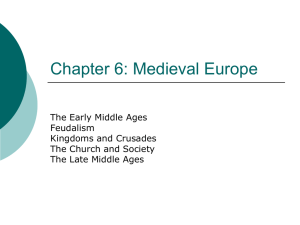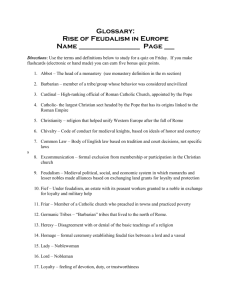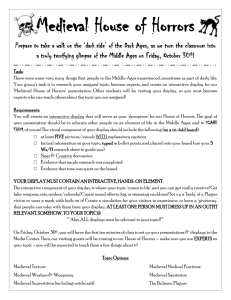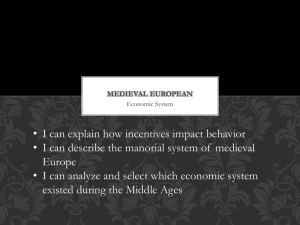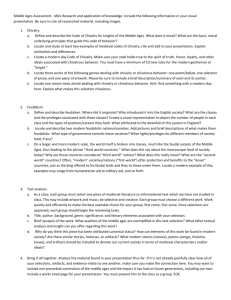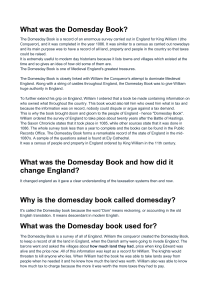Introduction To Middle English
advertisement
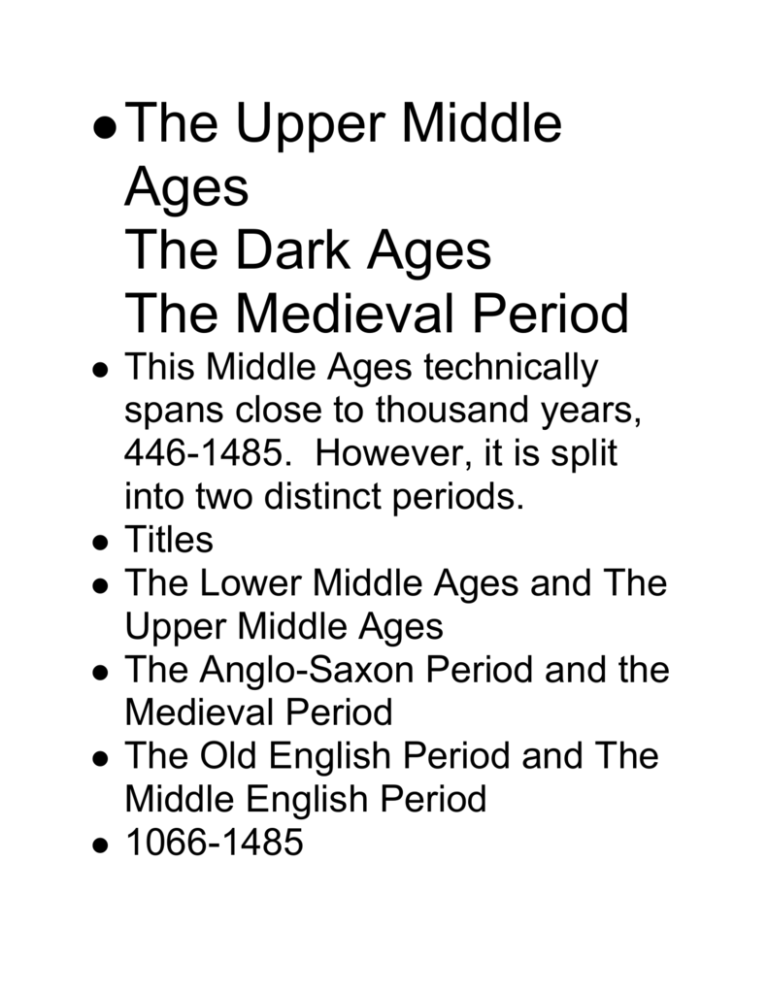
The Upper Middle Ages The Dark Ages The Medieval Period This Middle Ages technically spans close to thousand years, 446-1485. However, it is split into two distinct periods. Titles The Lower Middle Ages and The Upper Middle Ages The Anglo-Saxon Period and the Medieval Period The Old English Period and The Middle English Period 1066-1485 • Known as the Medieval Period When William the Conqueror invaded England, this was not another hit and run invasion; it was a full- fledged invasion. When William took over as king, the language changed, the customs changed, and these changes influenced the entire island. Thomas a Beckett (or Becket) Became Henry II’s Lord Chancellor and later Archbishop of Canterbury. After Beckett was made Archbishop, he defended the claims of the Church against the interests of the King, for which he was murdered by several of Henry’s knights. Therefore he became a saint of the Church and a hero of the people. Remember, the place he was murdered became a holy site. The Land and the Feudal System The year 1066 brought the largest change of land ownership in the history of England. William introduced the idea of feudalism—feudalism was a complicated system of landholding. Nobody owned land independently but only as a vassal of an overlord, who in turn owned allegiance either to some great noble or to the king. The system was really an elaborate chain of loyalties, with rent, so to speak, paid principally in military service to the overlord. It worked like this: it exchanged land for personal service. The person who granted the land was the overlord, and the person who received it was the vassal. The vassal promised service to his lord (as an act of homage). The Domesday Book (Doomsday) The Domesday books listed all the landowners and showed the extent of their claims. This was an administrative feat without equal because now taxes could be based on real property. The Medieval Church The Medieval Church helped establish a common set of beliefs, culture Latin, the language of the Church, became the language of all educated persons. The Medieval Church was the most powerful institution or organization in Europe at this time. . .more powerful than royalty and the monarchy . . .it controlled everything. . .education, cultural events, etc. and everything was funneled through the church. The Pope became the most powerful person in Europe The church became corrupt (this corruption is reflected in the CT’s) Medieval Life Most people lived in the country and were attached to a feudal manor. There they worked their own fields and the lands of the lord of the manor, to whom they owned their allegiance. As the period progressed, however, farming became less important than herding. The wool produced by English sheep was desirable, so it became worthwhile to turn corn fields to pastures. This economic development greatly altered the daily life of the common man. The common people now paid what they owed their overlords from their wages rather than in farm labor. More an more people began to live in towns and cities rather than on manors. A whole new class of merchants grew up. The first people to form guilds (labor unions) were the merchants With prosperity and a simultaneous growth in population, the English turned to other kinds of work. This is the period of the great English cathedrals. Much of communal life of the city centered upon these magnificent monuments. English law The term common law refers to law that is common to the whole country and all its people, in contrast to kinds of law applying only to certain classes of persons. One significant law that came into effect during this period was the law of primogeniture, which gave the firstborn son exclusive right to inherit his father’s titles, lands, and estates. Ordeals During the early part of this period, matters of law were settled by what were called ordeals. People’s innocence or guilt was settled by setting them tasks, and if they were successful at them, they were judged innocent. Magna Carta (1215) In it we can see foreshadowed the right of trial by jury, habeas corpus, or the right not to be illegally detained, and the beginning s of representative government in Parliament. Originally, it was just a way to solve tax disputes, but it became the foundation for some of our rules and laws today. The Crusades Each Crusade began in high hope, in a genuine desire to rescue Jerusalem from the Turks, but most ended squalidly in raiding, looting, and a tangle of power politics (done in the name of God). It was the Crusades too, even though they ended badly, that encouraged the ideal of true knightly behavior known as chivalry. The medieval idea of chivalry, though it included the relations between the sexes, sought, with the aid of the Church, to make the knightly warrior as devout and tenderhearted off the battlefield as he was bold and fearless on it. The Hundred Years’ War Unfortunately for both England and France, the English monarchy never voluntarily relinquished its hold on its French possessions. As a result, there were numerous costly wars in France, culminating in the series of wars now known as the “Hundred Years’ War” (1337- 1453). England won many battles, but they were eventually driven from France. The War of the Roses In 1348 England was struck by the Black Death, the first of a series of plagues that killed more than a third of the population. The scarcity of labor caused by the plagues was the death knell of feudalism. The War of the Roses (14551485) A civil war between the House of York, whose emblem was the white rose, and the House of Lancaster, symbolized by a red rose; it ended when the two feuding families united through marriage. Medieval Literature and Romance The form of literature favored by the Anglo-Normans was the romance. Medieval romance consisted largely of tales of chivalry to which were added a love interest and all sorts of wonders and marvels(giants, fairies, wizards, dragons, etc). King Arthur is a good example Geoffrey Chaucer The first truly great figure in English literature that we know about was Geoffrey Chaucer. He was not only a great poet and a fine storyteller but also the first of the poker-faced humorists. Folk Poetry and Drama During religious festivals, the trade guilds entertained the crowd with miracle plays—rough dramatizations of Biblical stories. Toward the end of the Middle Ages in England, during the dark troubled times of the fifteenth century, the miracle plays gave place to the morality play. They tended to be elaborate and sophisticated dramatic allegories in which characters representing various virtues and vices confronted each other. Questions 1. Give the historical significance of the dates 1066-1485. What system of landholding did William the Conqueror introduce into England? A: This is the time frame known as the medieval period. A: William the Conqueror introduced feudalism into England. 3. Why did William have an inventory of property drawn up in the Domesday Book? A: He wanted to know what land people owned so he could tax the land. 4. Why is the Medieval Church considered the most important cultural institution of the period? 5. What economic development was responsible for the growth of cities and the merchant class? A: The Church was at the center of learning and culture. It was very powerful and it became the dominant force in preserving and transmitting culture. A: The widespread production of wool and woolen fabric 6. What is the connection between the Magna Carta and present-day representative government? A: It became the foundation for some of our rules and laws today. 7. In what way did the Black Death help to bring an end to the institution of feudalism? A: The scarcity of labor caused by the plagues was the death knell of feudalism. 8. Name the two important English wars that were fought during the Middle Ages. Who was involved and what was the outcome? #1: “Hundred Years’ War” (13371453) between England and France; England won many battles but French drove the English out of France. #2: The War of the Roses (14551485) , a civil war between the House of York and the House of Lancaster; it ended when the two feuding families united through marriage. 9. What form of literature illustrates the medieval ideal of chivalry? A:The romance 10. What two kinds of drama flourished during the Middle Ages? A: Morality plays and miracle plays

